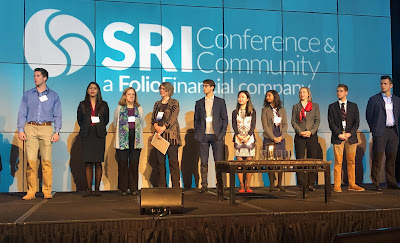
In the aftermath of another round of divisive elections in the United States (and around the globe) many of us feel distraught about the ability and speed of our political systems to address urgent social challenges. Political change requires organizing and community- slow but necessary processes. Meanwhile, from climate change to income inequality, gentrification and displacement to the gender-wage gap, the challenges we face as a society seem more acute than ever. Votes may have been cast and ballots counted, but that does not mean we must wait another two years for our next chance to shape our world. There are other avenues by which we can continue to make change.
Last week I attended the SRI Conference in Colorado Springs as one of twelve conference scholars, where I got to see how investors perceive of their role in mobilizing finance for energy decarbonization and how they are integrating climate change risk into investment decisions. I met people that have spent decades working to spread awareness and develop the tools to leverage the power of investments to achieve better outcomes for society: individual retirement advisors, endowments for religious orders, the City of Chicago, the Sierra Club Foundation — Socially Responsible Investing (SRI) is being practiced throughout the investment industry.
The principle is straightforward: when we own a piece of a company, be it via public markets, as debt, or as private equity, we are reducing that company’s cost of capital. In a way, we are betting that a company’s business model, practices, and products will contribute to a better, more prosperous world in the future.
This is what I call voting with your investment dollars, and this vote takes place every month of every year. Directly or indirectly, through our educational institutions, pension and retirement funds, and government treasuries, we are all investors in the global economy. But where do we direct this capital? To whom do we entrust it to be used well, and to build a foundation for our long-term personal and communal well-being? We are stakeholders in the economic system, but many of us do not wield this power with as much purpose as we could.
I work with many people that strive to make such changes in the energy sector, where the financial factors that hinder the development of sustainable energy are perhaps just as daunting as the scientific, technical, and political barriers. Development in both the fossil-fuel and clean energy sectors is shaped by the market appetite for risks associated with investing in new projects, be they a new coal plant or an array of solar panels, which translate into the cost of capital for that project. These equations only account, however, for the internalized risks and costs that project investors are assuming. These may not be the same as the costs faced by society as a whole; they may not account for externalities. When determining our “required return,” investors have the opportunity to thoughtfully consider which risks they are willing to bear and what future they hope to facilitate with their capital for society at-large.
Why is Socially Responsible Investing hard?
Basic microeconomic principles show us that there are plenty of instances where corporate profit maximization can be misaligned with socially optimal outcomes, especially when those internalized benefits create externalized costs. In these cases, a rational business decision or practice that we are facilitating through our investments might run counter to our own long-term priorities and needs. There are lots of reasons why externalities are often not accounted for, such as measurement challenges, information asymmetry, and principal-agent issues. A classic example of private profit running counter to society’s values is the tobacco industry, where much of the healthcare costs that result from tobacco externalities are borne by society as a whole. This tension motivated famed moves by government agencies, such as CalPERS that manages health and retirement for California employees, to divest from tobacco. Even though this meant foregoing short-term profits, the long-term payoff was clear in the eyes of former California Treasurer Phil Angelides: “What sense does it make for CalPERS to be an investor in companies that cost the state billions of dollars?”
Avoiding negative externalities is a start, but investors are increasingly aiming to finance positive impacts. At this conference, Chicago City Treasurer Kurt Summers shared that his office sees its investment dollars as a way to “make a positive impact on some of the most fundamental challenges facing Chicagoans.” Considering environmental, social, and governance (ESG) factors helps his office promote conservation and sustainability, racial and gender equity, better labor standards and more, all of which improve the quality of life for both the current and future Chicago community. I am especially pleased to see that the Treasurer’s Office is setting concrete goals for itself, such as achieving a carbon neutral investment portfolio by 2020. The city recognizes that as a first-mover it is a catalyst for change and is using this position to test new approaches and move new efforts forward.

Under this banner of impact there were a number of innovative approaches to mobilizing finance for energy decarbonization and sustainable development on display at the conference. I chatted with folks from the Iroquois Valley Farmland REIT, who are making investments in organic farmland, and with clean energy project developers from Clean USA Power; both companies are applying financial products in new ways to move finance towards positive impact. I also enjoyed learning more about my favorite startup, Hyphae Partners, which works to bring finance to businesses that practice regenerative agriculture.
By definition, these negative externalities and positive impacts are not captured in traditional financial information. However, the finance industry is awakening to the notion that non-financial information can be material to a company’s economic performance. This is illustrated by the groundbreaking work of Sustainability Accounting Standards Board (SASB) and the Task Force on Climate-related Financial Disclosures (TCFD), which are setting standards for corporate sustainability disclosures across industries and asset classes. Better sustainability information allows investors to employ more precise strategies when they invest in their values. SRI strategies were developed decades ago and have been continuously refined over the years, evidenced by the fact that this year’s conference was the 29th reunion of these industry practitioners.

This year’s 29th SRI Conference provided attendees with a rich snapshot of a dynamic, multifaceted industry. This snapshot illuminated the industry’s shift from niche to mainstream, a growth in asset types and sectors represented, and a welcome intentionality around diversity of representation and perspectives. These trends ensure that this conference will continue to be a fascinating window into a the finance industry and bell-weather for its future. To read more about what you can do to align your personal finances with a future you want to live in, check out Nick Depsky’s great Life@ERG posts on Personal Banking and Retirement Accounts + Mutual Funds.
Banner photo credit: natsihlaneone on Flickr